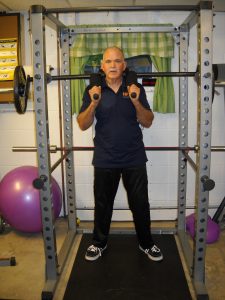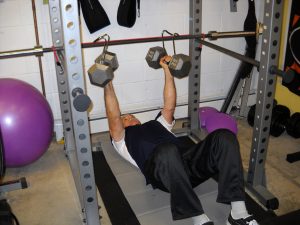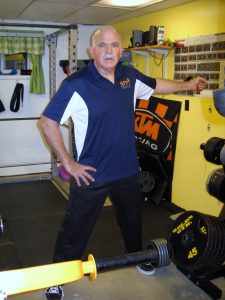Free weights propose a risk for injury while machines can be limiting. As trainers we have to weigh the benefits against the risk in order to determine the best exercises to use. I use these four free weight exercise devices and related exercises to get all of the benefits of using free weights while limiting the risk.
Below you can find the reasons why these exercises are a great alternative and a link for how to do each exercise with additional information included about each one.
#1 Shrug Bar Deadlift
- The lifter is standing in the center of the load so the line of pull is centered on the body.
- The handles are elevated above the bar to more easily keep a flat back while in the starting position.
- Hands are in a natural hanging position with the palms facing each other providing a better grip.
How to do a Shrug Bar Deadlift
#2 Safety Squat
- The weight is cambered forward which helps the lifter to stay in a more upright position during a squat.
- The handles are placed in front of the lifter, allowing to more easily hold the bar in position without placing stress on the shoulders.
- The bar itself sits around the user’s neck and has more surface area to spread the weight on the trapezius muscles.
- The bar is nicely padded for comfort.
#3 Floor Dumbbell Chest Press with Power Hooks
- Power hooks provide a racked dumbbell that is easy to grab and un-rack.
- The spin lock dumbbell handles create the ability to add or subtract weight while they are hanging.
- The upper arms come in contact with the floor at the bottom of the rep range, taking stress off the shoulder girdle.
- It is easier to get the dumbbells to the floor in the case of complete failure.
How to do a Floor Dumbbell Press with Power Hooks
#4 Unilateral Band Fly
- The load gets progressively greater as the band stretches on many exercises, causing less stress at the starting position.
- Power is developed because of the need for limb acceleration as the band stretches and resistance increases.
- Tubing challenges the shoulder muscles in multiple planes of motion.
How to do a Unilateral Band Fly
Try one or all of these four exercises in place of one of your “go-to’s” and see for yourself how it changes the flow of your routine. They work well for me and generally healthy people in my age group because they provide safety while still providing a challenge.
[info type=”facebook”]Do you have any favorite exercises or equipment? Please share your comments on Facebook. If you’re an NFPT trainer, join the Facebook Community Group to share and if you’re not, come chat with NFPT here![/info].
John Rutnik is a NFPT Certified Personal Trainer. He holds an AAS in Electrical Technology and has been a certified personal trainer since 2008. John has been involved in physical fitness and weight training since the late 70’s and is an avid outdoors man. He became a personal trainer after rehabilitating himself from a spinal injury he sustained in a car accident and losing 70 pounds. John later obtained ISSA Certifications as both a Fitness Trainer and Specialist in Sports Nutrition and became Lead Fitness Trainer at Anytime Fitness in Schenectady NY. His training philosophy is “no man left behind,” everyone deserves a chance to succeed.





